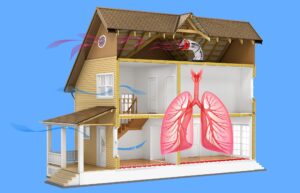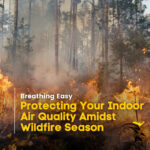When it comes to protecting your family’s health, we all want to take it seriously. However, the Environmental Protection Agency has news that may surprise you –the air quality in your house can be more contaminated than the air outside, even in big cities where there is more pollution!
Studies show that most Americans spend nearly 90% of their lives indoors. While you’re there, do you want to be breathing in air that’s just as dirty as the air outside? Of course not! It’s your home, it’s your air quality, it’s your lungs.
But don’t fret as there are steps that you can take to improve the air quality within your home.
Knowing Your Invisible Enemies
The first step to improving the air quality in your home is to determine what pollutants are causing potential serious damage to your health. The Environmental Protection Agency says these indoor pollutants can be classified into three categories:
- Combustion Pollutants: Common combustion pollutants include carbon monoxide and nitrogen dioxide. These colorless and odorless gases originate from burning objects that are incorrectly vented or not vented at all. The type and number of pollutants created depends on the installation, maintenance, and ventilation of the appliance, as well as the type of fuel it utilizes.
- Volatile Organic Compounds (VOC): These organic chemicals disseminate as gases that came from particular solid or liquid materials which most likely are the household products you often use.
- Triggers to Asthma and Other Allergies: You may not know it, but your home may be host to a culture of dust mites on your blankets, pillows, or stuffed toys, mold on shower curtains, and cat or dog hair all over floors or upholstery which can trigger nasty allergy or complications due to asthma.
Limit Your Exposure
Now that you know your invisible enemies, it is time that you drastically cut down your exposure to it.
- Let fresh air come inside and ventilate your home by opening your windows as often as possible.
- Change or clean air filters regularly –especially the ones from your air purifier, furnace or heater, vacuum, and air conditioner.
- Humidity levels are important in controlling the growth of mold and mildew. Set up your home’s humidity level to an ideal 45%. A humidity level below 30% is too dry while over 50% can make your home too moist making it an open breeding ground for molds. You may want to use a humidifier or a room vaporizer to increase the humidity in your home. To decrease it, open your windows, use your fan, dehumidifier, or air conditioner.
- Go natural with DIY air fresheners and avoid synthetic ones that emit damaging chemicals or hormone disruptors.
- Use a HEPA air purifier that doesn’t generate ozone and eliminates VOCs from furniture, paint, or cleaning materials.
- Go green by planting green plants in your home, particularly those from a list supplied by your friends at NASA. These can help lessen VOCs and enhance the air quality of your home.
- Set a regular grooming schedule for your pets.
- When painting your home, only use the kind that has low or no VOC and always pick non-toxic adhesive, finishes, and varnishes as much as possible
Be Clean, Be Smart.
To improve the air quality in your home, how you clean and what you use to clean really matters.
Reduce Dust and Pollutants
A high-performance vacuum with powerful suction, HEPA filters, and rotating brushes can be a very good investment as it catches tiny particles that regular vacuums often miss. Do this once a week and make sure to regularly wash or change your vacuum filter. If you don’t have time for regular vacuuming, consider an automatic vacuum that does the job for you.
Use a damp cloth to wipe the tops of window frames, doors, and sills, and wash your curtains often. You may buy a reusable microfiber dust mop to reach nooks and crannies that vacuum could not.
Use quality mattress, pillow, and box spring covers that are dust-mite-proof.
And to prevent against the growth of mold, of which spores can be toxic, use environmentally-friendly materials when cleaning your shower and regrout your tiles if needed.
Stop Using Aerosols
The use of aerosols has long been believed to harm the environment, as well, and it does. Most fragranced products are derived from petroleum products which are non-renewable, polluting resources.
Products such as air freshener, deodorant spray, furniture polish, hair spray and carpet cleaner all contain artificial fragrances that often contain volatile organic compounds (VOCs) that are considered toxic or hazardous. And all the product label has to state is that the product contains “fragrances,” so you’ll never know when there is actually a deadly chemical hidden in there.
Releasing them into the air causes an irreversible negative effect on the environment.
So what can you do? Stop using aerosol products. Opt, again, for homemade products to replace them using all-natural ingredients, or choose fragrance-free products.
Let the Outdoors In
Open a window in your house! Letting in some fresh air will not only combat the potentially deadly pollutants that have been emitted into the air in your home unknowingly, but it can be a natural way to cool your home during warmer months, too.
Depending on where you live (cities and highly populated areas tend to have poorer air quality than the suburbs and open country spaces), the air quality outside may actually be better than that inside your home. The fresh air can help clear out the polluted air that you’re breathing indoors.
And if it tends to heat up quickly in your home, instead of turning on the air conditioning immediately when it warms up outside, try opening the windows for a natural breeze to flow throughout your home to cool it off. You’ll save tons of energy this way and it’s really an effective cooling technique (assuming you get a good air flow). Check out the Quiet Cool Whole House Fans for AC alternatives to cooling and fresh air options
Decorate With Plants
Just as plants outside filter the air we breathe, indoor plants can help improve the air quality within your home, as well.
Decorate using strategically placed air-filtering house plants throughout your home. They have capabilities of filtering out any pollutants that may be in the air in your home and return to you clean, breathable air.
House plants are also said to have an effect on mood and the general feeling of overall well-being. The bottom line: plants are good for you and good for the environment on all levels, so adding them to your home will only help improve your life and the air that you breathe!
TEST FOR RADON
Radon is the second leading cause of lung cancer in the United States. The EPA says that radon moves up from the ground into homes through cracks and holes in the foundation. It is estimated that one in fifteen homes in the U.S. have elevated radon levels.
The health risks from living with radon stem from breathing radioactive particles that become trapped in the lungs and can result in tissue damage, which can lead to lung cancer over a lifetime. However, not everyone exposed to higher levels of radon will develop lung cancer.
The EPA and the Surgeon General recommend indoor air quality testing for radon in all homes below the third floor
The EPA recommends taking a test as the first step. If you find that your radon level is 4 picocuries per liter (pCi/L) or greater on a regular basis then fixing your home would be the next step by adding a Radon mitigation system.
There are many proven methods to reduce the radon level in your home, and the primary way is by using a vent pipe system and fan. The cost will depend on your home, but for most, it can be fixed for about the cost of a simple home repair. Lowering radon levels requires technical knowledge and skills, and it is best to work with a contractor who has been trained to fix radon problems. Let us know if Radon has been a problem in your home.
RELY ON TRUSTED PROFESSIONALS
Finally, For your home to be a safe haven for your family and to ensure their health, you must improve the air quality inside it! Hopefully these tips will put you on the track to a greener, healthier home , if you need help, Lion Home Service can take care of all your indoor air quality. We service all of Northern Colorado in Fort Collins, Loveland, Greeley, Longmont, Boulder, Windsor and surrounding areas. Call us today! 970-399-9940 .











